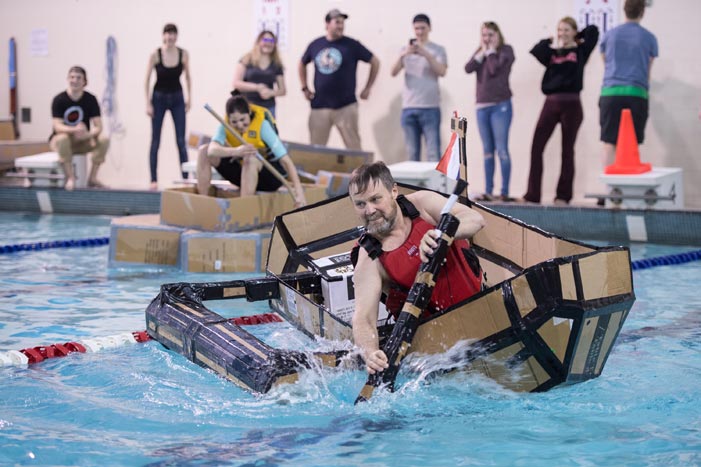University of New Brunswick engineering students battle for cardboard boat supremacy
Author: Communications
Posted on Apr 4, 2017
Category: UNB Fredericton
 Cardboard boat. It sounds like the first half of a joke someone forgot to finish. But second-year civil engineering students at the University of New Brunswick are building eight of them to race Tuesday, April 4, 2017, at 2:30 p.m.
And the stakes are high. These aren’t model ships – these boats will need to hold the students’ professors.
“I’ve thought about putting the students in the boat. I’ve also thought about building little ones. But I think having it real size and putting a professor in the boat puts more skin in the game,” says Dr. Katy Haralampides, who teaches the second-year civil and geological engineering students. “You’re talking to a person who typically doesn’t endorse competition in the classroom, but I think that they have put more into it, wanting to have their professor win the race.”
This is the second year for the competition, being held at the Sir Max Aitken Pool on UNB’s Fredericton campus. Dr. Haralampides thought the project would be a way to combine several of the subdisciplines involved in civil engineering. Cardboard was chosen as the base material to increase the challenge while ensuring the students would have ready access for prototyping.
“A project based in water allows them to calculate the forces using buoyancy equations and they can also analyze the boat from a structural mechanics point of view,” said Dr. Haralampides. “Not only the load from a passenger but also the force that’s on the paddle going through the water.”
Although the race uses friendly competition to motivate the students, they will not be graded on the race results.
Dr. Chris Diduch, UNB dean of engineering, sees the complexity of the undertaking as a way to integrate skills beyond engineering.
“Students must bring their problem-solving, teamwork and design skills as they create a human-powered boat constructed out of cardboard and duct tape,” said Dr. Diduch. “Not only is it an exciting event for students, it helps to develop engineering and teamwork competencies where the emphasis is on creativity and fun.”
The students don’t have free reign over the design. Some rules are in place to ensure that the boats will fit in the pool itself. Others are to make sure that the central challenge, working with cardboard as a material, is preserved.
“Three metres is the maximum length of the boat. It has to be cardboard and have two points of contact with the water, like a catamaran,” said Dr. Haralampides. “Duct tape is allowed within eight centimetres of a seam of cardboard. Last year, I allowed them unlimited duct tape so they just wrapped it and it was a duct tape boat.”
Media contact: Colin Hodd
Cardboard boat. It sounds like the first half of a joke someone forgot to finish. But second-year civil engineering students at the University of New Brunswick are building eight of them to race Tuesday, April 4, 2017, at 2:30 p.m.
And the stakes are high. These aren’t model ships – these boats will need to hold the students’ professors.
“I’ve thought about putting the students in the boat. I’ve also thought about building little ones. But I think having it real size and putting a professor in the boat puts more skin in the game,” says Dr. Katy Haralampides, who teaches the second-year civil and geological engineering students. “You’re talking to a person who typically doesn’t endorse competition in the classroom, but I think that they have put more into it, wanting to have their professor win the race.”
This is the second year for the competition, being held at the Sir Max Aitken Pool on UNB’s Fredericton campus. Dr. Haralampides thought the project would be a way to combine several of the subdisciplines involved in civil engineering. Cardboard was chosen as the base material to increase the challenge while ensuring the students would have ready access for prototyping.
“A project based in water allows them to calculate the forces using buoyancy equations and they can also analyze the boat from a structural mechanics point of view,” said Dr. Haralampides. “Not only the load from a passenger but also the force that’s on the paddle going through the water.”
Although the race uses friendly competition to motivate the students, they will not be graded on the race results.
Dr. Chris Diduch, UNB dean of engineering, sees the complexity of the undertaking as a way to integrate skills beyond engineering.
“Students must bring their problem-solving, teamwork and design skills as they create a human-powered boat constructed out of cardboard and duct tape,” said Dr. Diduch. “Not only is it an exciting event for students, it helps to develop engineering and teamwork competencies where the emphasis is on creativity and fun.”
The students don’t have free reign over the design. Some rules are in place to ensure that the boats will fit in the pool itself. Others are to make sure that the central challenge, working with cardboard as a material, is preserved.
“Three metres is the maximum length of the boat. It has to be cardboard and have two points of contact with the water, like a catamaran,” said Dr. Haralampides. “Duct tape is allowed within eight centimetres of a seam of cardboard. Last year, I allowed them unlimited duct tape so they just wrapped it and it was a duct tape boat.”
Media contact: Colin Hodd
